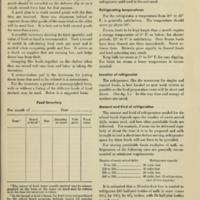Storage For School Lunch Food and Supplies
Title
Storage For School Lunch Food and Supplies
Creator
Date
1949
Relation
Program Aid Number 63
Excerpt
Well-planned storage for food and supplies makes for efficient and economical school lunch operation. Proper storage of food helps to protect the health of the children who eat lunches at school, to conserve food values, and to prevent waste. Furthermore, storage facilities that are well-planned in relation to work centers save time and energy of workers and so reduce labor costs.
In recent studies of school lunch programs, storage problems were found to be numerous. In some schools storerooms were too small, or located too far from the kitchen. On the other hand, a few schools had store- rooms larger than necessary. Refrigerator space was sometimes too limited for proper storage of perishable foods. Storage space for small equipment was not always conveniently arranged at the work centers where it was used. Often workers did not have a suitable place for their street clothes and other personal belongings. Where space was satisfactory, it was not always used to best advantage.
Problems such as these need careful consideration in planning lay-out of space for new school lunch- rooms, in remodeling or enlarging lunchrooms already in operation, or in deciding upon management practices that will make most efficient use of the storeroom. This publication is intended to direct attention to storage problems, give help in planning and evaluating storage facilities, and serve as a guide to accepted practices in storage management. The contents may well be used as an outline for fuller discussion by those interested in the preparation and serving of school lunches.
In recent studies of school lunch programs, storage problems were found to be numerous. In some schools storerooms were too small, or located too far from the kitchen. On the other hand, a few schools had store- rooms larger than necessary. Refrigerator space was sometimes too limited for proper storage of perishable foods. Storage space for small equipment was not always conveniently arranged at the work centers where it was used. Often workers did not have a suitable place for their street clothes and other personal belongings. Where space was satisfactory, it was not always used to best advantage.
Problems such as these need careful consideration in planning lay-out of space for new school lunch- rooms, in remodeling or enlarging lunchrooms already in operation, or in deciding upon management practices that will make most efficient use of the storeroom. This publication is intended to direct attention to storage problems, give help in planning and evaluating storage facilities, and serve as a guide to accepted practices in storage management. The contents may well be used as an outline for fuller discussion by those interested in the preparation and serving of school lunches.
File(s)
Storage For School Lunch Food and Supplies Cover.jpg
(image/jpeg)
Storage For School Lunch Food and Supplies TOC.jpg
(image/jpeg)
School Lunch Layout.jpg
(image/jpeg)
Storage For School Lunch Food and Supplies 2.jpg
(image/jpeg)
Storage For School Lunch Food and Supplies 3.jpg
(image/jpeg)
Storage For School Lunch Food and Supplies 4.jpg
(image/jpeg)
Storage For School Lunch Food and Supplies 5.jpg
(image/jpeg)
Storage For School Lunch Food and Supplies 6.jpg
(image/jpeg)
Storage For School Lunch Food and Supplies 7.jpg
(image/jpeg)
Storage For School Lunch Food and Supplies 8.jpg
(image/jpeg)
Storage For School Lunch Food and Supplies 9.jpg
(image/jpeg)
Storage For School Lunch Food and Supplies 10.jpg
(image/jpeg)
Storage For School Lunch Food and Supplies 11.jpg
(image/jpeg)
 An official website of the United States government.
An official website of the United States government.














